#fidei-defensor
Explore tagged Tumblr posts
Text

A dex si inizia a incrociare sempre più sovente post come questo, al posto di noiose menate da anticap-pati su Putain Defensor Fidei e come faremo ora senza Assad.
E' un bel segno, come gli applausi ad Atreju per il CONCITTADINO JAVIER MILEI; segnala che la reazione scomposta alla fuffa allucinogena woke si va diradando e stan diventando patrimonio comune concetti prima riservati a pochi, che il Nostro semplifica e rende manducabili per tutti - il primo: CHI DEVE FAR SACRIFICI E' SOLO LA BESTIA - e i suoi attaché parassitari sinistri.
Grazie Giorgia per averlo invitato - mai avrei pensato di esser grato sul piano culturale ideale a un ex Msi.
23 notes
·
View notes
Text
henry viii receiving (three) golden rose(s), the title of fidei defensor, and a writ of excommunication all inside thirty years:

#not all from the same popes#mind you...but still. funny#altho clement did give him a golden rose like three years before he requested an annulment. a bit of context on why henry thought it'd be#achieved within like...a year?#also most think clement excommunicated henry but it was pope paul iii#clement gave him like a...'placeholder' ? excommunication? a warning of excommunication? not an official one#and yes. three different popes gave him the golden rose
8 notes
·
View notes
Text


THE MONARCH AND THE MONARCHY 5 commoners have been enfranchised since 1848, the " nation" in Hungary is still a close corporation standing in a special relationship to the Monarch with whom it makes a fresh bargain at every coronation. Much of the uncertainty in regard to the future of the Hapsburg dominions springs from apprehension lest the future monarch should conceive his "mission" to consist in the reduction of the Magyars to a position in the Monarchy commensurate with their numerical importance and with their status as a minority among the citizens of Hungary; and lest he, drawing his inspiration from the reign of Joseph II. rather than from the later years of Francis Joseph, should seek to substitute for the Dual System some form of centralized unity. Such an effort would be by no means unprecedented in Hapsburg history, and, if deftly and vigorously made, by no means certain to fail. The Hapsburgs have been defined by a modern Austrian writer' as "born artists," in that they lack the sense of reality and create a special world for themselves, each according to his own temperament or " mission." Lands, peoples, and men are their materials. In this respect Ferdinand II. and Joseph II. were the most typical. Ferdinand, drawing his inspiration from the Virgin Mary under Jesuit guidance, accomplished the terrible miracle of transforming Austria in thirty years from a Protestant into a Catholic country. Determined to save the souls of his people, he fulfilled to the letter his saying, "Better a desert than a land of heretics." The thoroughness of his work, | and the consistency with which he earned, by fire and sword, confiscation and banishment, torture and execution, his proud title, Catholicae Fidei Acerrimus Defensor, are hard to realize in our modern world of tentative policies and halting performance. Ferdinand II. made Austria materially
performance. Ferdinand II. made Austria materially and morally a desert, some parts of which have never since blossomed; but he made it Catholic. Joseph II., the en- throned Jacobin, drawing his inspiration from the Goddess 1 Hermann Bahr, Wien, pp. 19-30.
Steed, H. Wickham. (1914). The Hapsburg monarchy. 3d ed. London: Constable and company ltd..
2 notes
·
View notes
Text



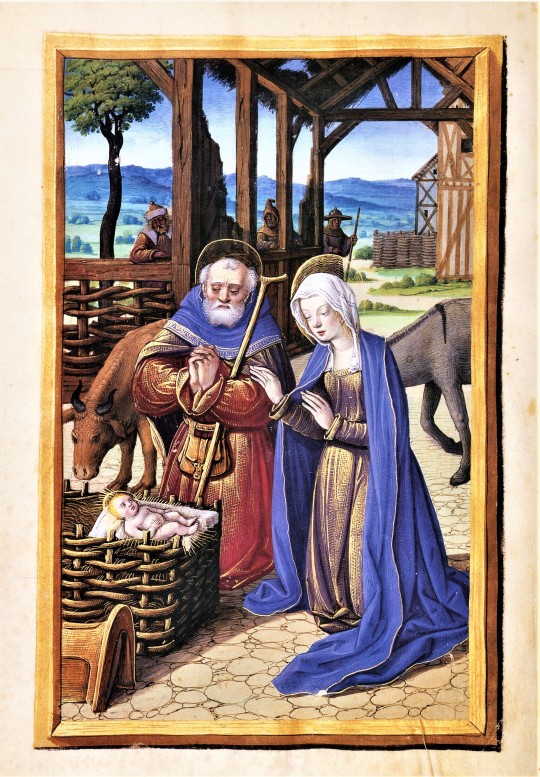

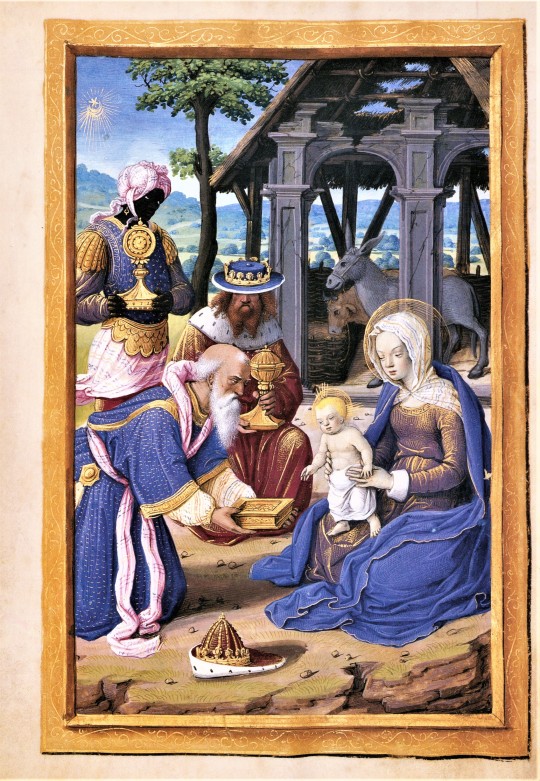
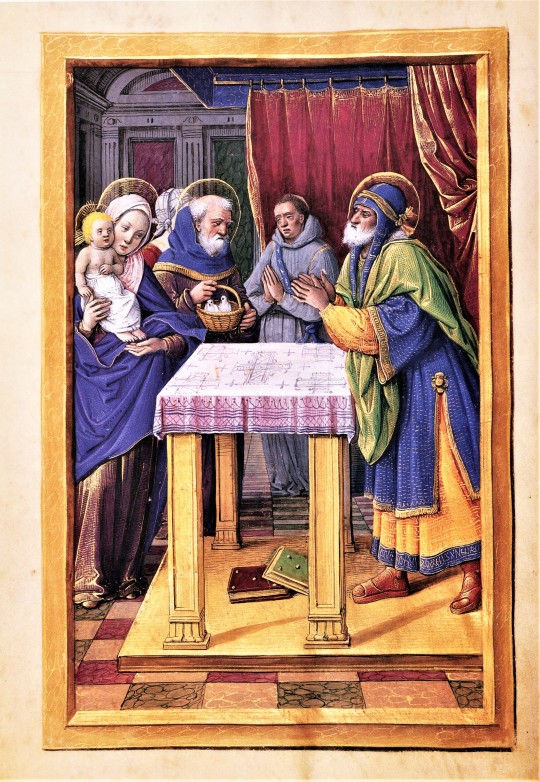
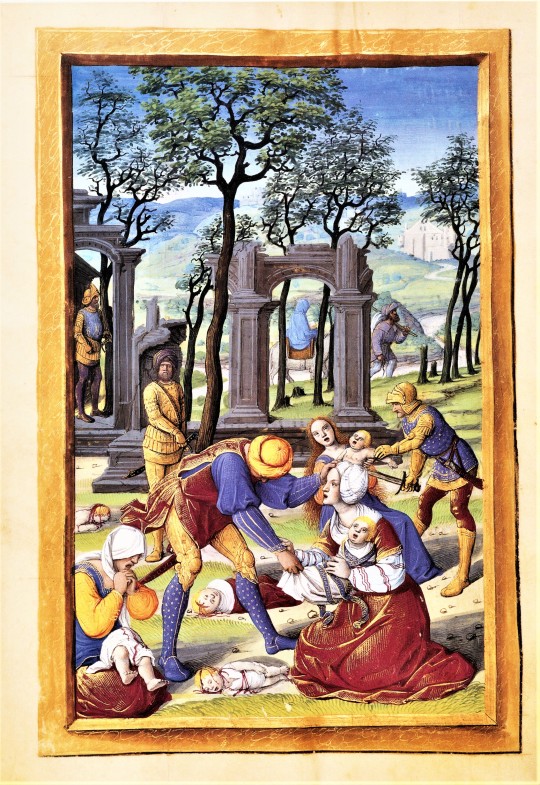
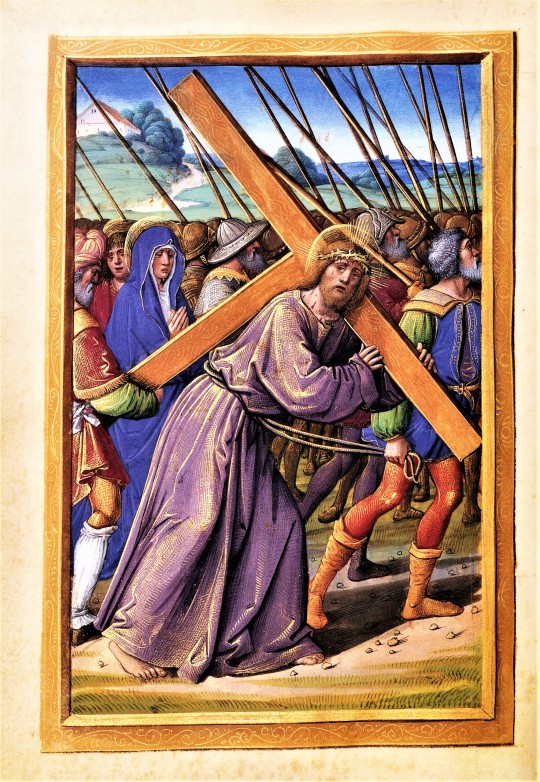
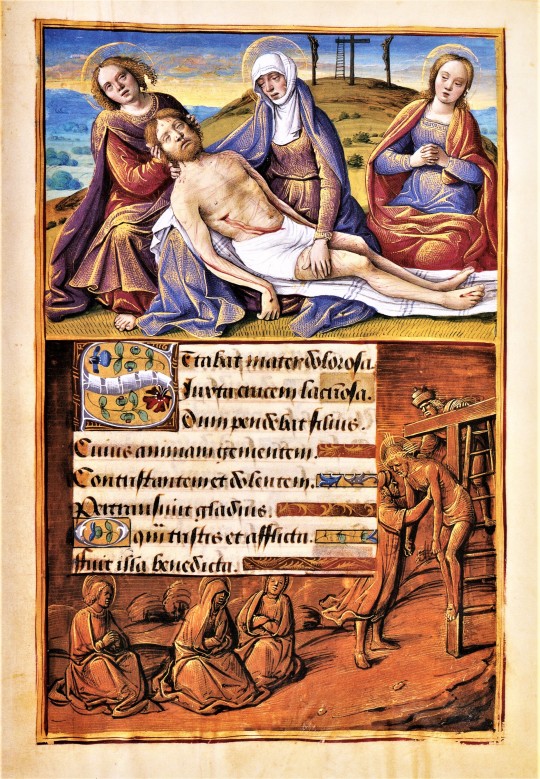
Milestone Monday
On this date, August 31 in 1535, King Henry VIII of England was excommunicated from the church by Pope Paul III. This was the culmination of a long series of conflicts and actions stemming from the king's desire to have his marriage to his first wife Catherine of Aragon annulled, which the previous Pope Clement VII opposed. This eventually led to a schism with the church in Rome and several excommunication proclamations by both Clement and Paul. Henry's confirmation as the Supreme Head of the Church of England in 1534, and then his execution of Bishop John Fisher in June of 1535, followed in July by the execution of Sir Thomas More, precipitated Paul III's excommunication order of August 31. On 17 December 1538 Pope Paul III issued a further bull renewing the execution of the August 31 bull, which had been suspended in a cautious hope Henry would repeal his behavior.
Henry was not always on the outs with Rome, and was in fact once considered a contemporary pillar of the church. In the early part of his reign, Henry was a devout and well-informed Catholic to the extent that his 1521 publication Assertio Septem Sacramentorum ("Defence of the Seven Sacraments") earned him the title of Fidei Defensor (Defender of the Faith) from Pope Leo X. One testament to his early piety might be seen in his probable ownership of this Book of Hours, known as The Hours of Henry VIII executed by the French miniature painter and manuscript illuminator Jean Poyet sometime between 1500 and 1503, and currently held by the Morgan Library in New York City. The images shown here are from "the Library's first monograph devoted to the oeuvre of a single illuminator," published by George Brazillier in 2000. Click on the Alt description of each image to view the titles.
View more Milestone Monday posts.
#Milestone Monday#milestones#Henry VIII#excommunication#Pope Paul III#The Hours of Henry VIII#Jean Poyet#Book of Hours#devotional art#illuminated manuscripts#Morgan Library#George Brazillier
34 notes
·
View notes
Text
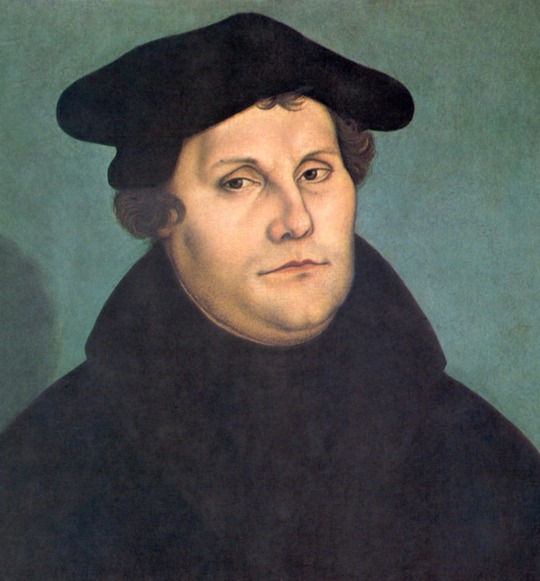
In 1517 an obscure German priest and academic, Martin Luther, set Europe ablaze with his Ninety-Five Theses protesting against the corruption of the Catholic Church. The Pope declared Luther a heretic, but his writings spread rapidly thanks to the printing press.
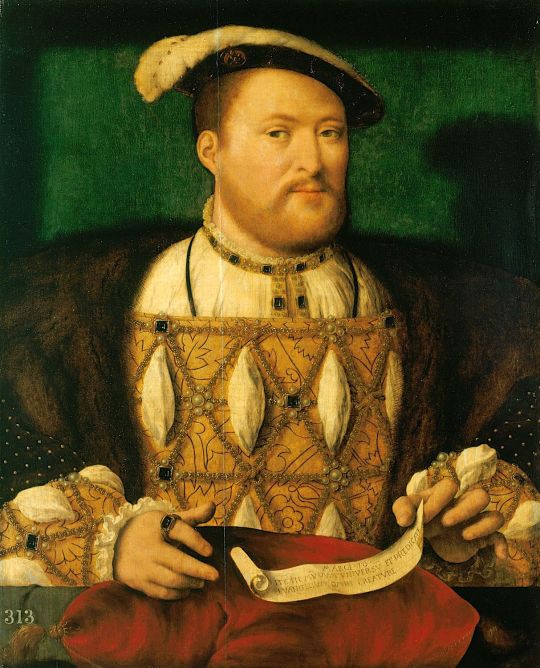
Not to be outdone, Henry VIII reacted by writing his own rebuttal in his Defence of the Seven Sacraments, which called for Catholics to reject such heretical views. John Foxe later wrote that although the book carried the king’s name, ‘yet it was another that administered the motion, another that framed the style’. Luther himself objected to the book on the grounds that it was not written by Henry, blaming Wolsey for its existence. It is possible that Wolsey, More or even John Fisher contributed to the final work, although as early as 1517 Henry had been composing his thoughts before sharing them with his advisers. With her education and intelligence, it is difficult to believe he did not discuss the matter with Catherine.
In 1521, Pope Leo X awarded Henry the title of Fidei Defensor, or Defender of the Faith. Wolsey presented the king with the papal bull, with a speech drawing on the observations of John Clerk, Henry’s ambassador to Rome, who had initially presented Leo with the work. It had been ‘beautiful to hear with what exultation the Pope and Cardinals broke out in praise of Henry, declaring that no one could have composed a better antidote to the poison of heresy’. With ‘great eloquence’, Henry had ‘completely refuted Luther by reason, Scripture and the authority of the fathers … and shown an example to Christian princes’. To make the point at home, Luther’s works were publicly burned at St Paul’s Cross, London, Oxford and Cambridge.
Amy Licence, Catherine of Aragon: An Intimate Life of Henry VIII's True Wife
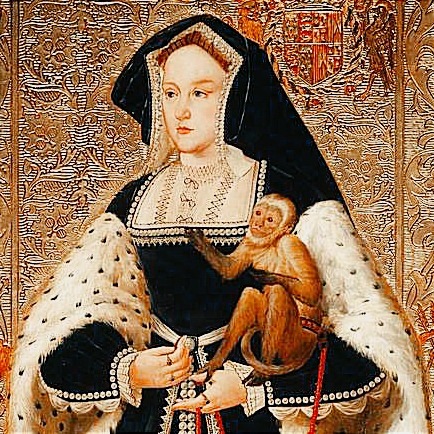
In 1523 a Spanish confessor of the Queen, Alfonso de Villa Sancta, wrote two anti-Protestant reform treatises Problema Indulgentiarum Aduersus Lutherum and De libero arbitrio aduersus Melanchthonem at Catherine’s request and dedicated to her. It would seem that she formed a willing part of the literary crusade launched against Martin Luther throughout Europe in the early 1520s. Villa Sancta gave Catherine the title Fidei Defensor. It is clear that prior to his break with the Roman Church in 1533, Henry VIII was willing to work with his first wife in denouncing Lutheran ideas.
3 notes
·
View notes
Text
Henry VIII ,Fidei Defensor
Pope Leo X granted King Henry VIII the title "Defender of the Faith" (Fidei Defensor) on October 11, 1521. This title was a reward for Henry VIII's written defense of the seven sacraments, specifically against the teachings of Martin Luther. Henry's work, titled "Assertio Septem Sacramentorum" (Defence of the Seven Sacraments), demonstrated his support for the Catholic Church at that time.
Ironically, less than two decades later, Henry broke from the Catholic Church and established the Church of England after his dispute with the Pope over the annulment of his marriage to Catherine of Aragon. Despite this break, English monarchs have retained the title "Defender of the Faith", and it is still used by British monarchs today, though its meaning has shifted over time.
0 notes
Text
Some British monarchs.
Every British sovereign from the reign of Edward III in 1327 to that of George III in 1801 was a pretender to the French throne. This claim originated in Edward III’s claim following his successful invasion of Scotland in 1333, triggering the Hundred Years’ War with French Valois loyalists, and abandoned under the reign of George III when Great Britain and Ireland were joined in real union in 1801.
ELIZABETH, FIRST OF HER NAME (b. 1533, d. 1603). Tudor. Ruled 1558–1603.
Elizabetha, Dei Gratia Angliae, Franciae et Hiberniae Regina, Fidei Defensor.
Elizabeth was the daughter of Henry VIII and his second wife and consort, Anne Boleyn, whom Henry had executed before Elizabeth was declared a bastard. Elizabeth is known as the “Virgin Queen” because she never married and died childless.
JAMES, FIRST OF HIS NAME AS KING OF ENGLAND AND IRELAND, SIXTH OF HIS NAME AS KING OF SCOTLAND (b. 1566, d. 1625). Stuart. Ruled 1603–1625 (England), 1567–1625 (Scotland).
Jacobus, Dei Gratia Magnae Britanniae, Franciae et Hiberniae Rex, Fidei Defensor.
James was the son of Henry Stuart, Lord Darnley, and Mary, Queen of Scots, and the first cousin once removed of his predecessor, Elizabeth. James was succeeded by Charles I.
(397 years later.)
CHARLES, THIRD OF HIS NAME (b. 1948). Windsor. Acceded on September 8, 2022.
Carolus Tertius, Dei Gratia, Britanniarum Regnorumque Suorum Ceterorum Rex, Consortionis Populorum Princeps, Fidei Defensor.
Charles is the son of Prince Philip, Duke of Edinburgh, and Elizabeth II. He has two sons, the heir apparent William, Prince of Wales, and Prince Harry, Duke of Sussex. The mother of his children, and his late former spouse, was Diana, Prince of Wales, of the Spencer family, who died in a car crash in Paris in August 1997.
0 notes
Text




IMAGENES Y DATOS INTERESANTES DEL 21 DE OCTUBRE DE 2024
Día Mundial del Ahorro de Energía, Día Mundial de la Ingeniería Clínica, Día de Regreso al Futuro, Semana Internacional de Prevención de la Intoxicación por Plomo, Semana Europea para la Seguridad y Salud en el Trabajo, Semana Internacional del Acceso Abierto, Año Internacional de los Camélidos.
Santa Úrsula, San Malco, Santa Griselda, San Severino, San Asterio, San Hilarión, San Zótico, Santa Celina y Santa Orofrigia.
Tal día como hoy en el año 1994
Un tribunal arbitral internacional falla a favor de Argentina en su conflicto con Chile por un estrecho valle entre montañas de forma rectangular de 12 km de ancho y unos 44 km de longitud conocido como el "Lago del Desierto", zona limítrofe entre ambos países de 530 kilómetros cuadrados. (Hace 30 años)
1952
Tras declararse el estado de emergencia en la colonia británica de Kenia, resulta detenido en una redada junto a 100 destacados rebeldes del movimiento Mau Mau, el líder nacionalista africano Jomo Kenyatta, por exigir la creación de un gobierno autónomo. A Jomo Kenyatta se le acusa de dirigir el ala extremista de los Mau Mau y de la creciente "anarquía, violencia y desorden" contra los europeos. (Hace 72 años)
1929
En Nueva York, EE.UU., el mercado bursátil muy sobrevaluado comienza su caída, y con ella el "Crack del 29" y la "Gran Depresión". Aunque la Bolsa de Wall Street tendrá una breve recuperación a mediados de semana, volverá a derrumbarse 7 días más tarde, el "Martes Negro", día en que se pondrán a la venta 16 millones de acciones y no habrá compradores. La confianza en el Mercado se habrá evaporado de un día a otro. La gente dejará de comprar a crédito y la burbuja económica estallará parando de sopetón la poderosa locomotora para el crecimiento: el consumidor americano que, renqueante, se meterá de lleno en la "Gran Depresión". A partir de ahí, todo irá en cadena: se elevarán los aranceles, los consumidores extranjeros dejarán de comprar bienes americanos, los negocios irán a la quiebra, los bancos cerrarán sus puertas, y la gente perderá su empleo a velocidad de vértigo. Diez años más tarde, aunque la economía comenzará a recuperarse, el país continuará afectado por el estallido de la enorme burbuja. (Hace 95 años)
1879
El estadounidense Thomas Alva Edison, que sólo pasó tres meses por la escuela y al que sus profesores consideraban un muchacho incapacitado para los estudios, inventa la lámpara eléctrica incandescente, la bombilla. Ha nacido la luz eléctrica. (Hace 145 años)
1860
En Argentina, una convención nacional proclama y jura la Constitución, basada en la de 1853, de la que se han propuesto 22 enmiendas que han sido finalmente aceptadas. Por el artículo 3º, de la nueva Constitución se declara capital de la Confederación Argentina a la ciudad que el Congreso declare por una ley especial, previa cesión del territorio por la correspondiente ley. (Hace 164 años)
1820
Decreto del general San Martín para la creación de la bandera y el escudo del Perú, a fin de que las fuerzas peruanas tengan una enseña bajo la cual combatir. (Hace 204 años)
1805
De noche y con muy mal tiempo, mucho viento y fuertes tormentas, la flota hispano francesa es destruida frente al cabo de Trafalgar (Cádiz, España) por la escuadra británica al mando del Vicealmirante Nelson, que fallece en la batalla víctima del disparo de un francotirador francés durante el combate. Con esta derrota, las líneas de comunicación entre España y sus colonias quedarán seriamente amenazadas. (Hace 219 años)
1521
En Inglaterra, el rey Enrique VIII se declara contrario a la doctrina de Martín Lutero y el Papa le concede el título de "Defensor fidei". A pesar de ello, el objetivo final de Enrique VIII no es otro que el de someter a la iglesia de Inglaterra a la autoridad de la corona. (Hace 503 años)
1520
La flota de Magallanes, alcanza un cabo al sur de la Patagonia que señala el estrecho que separa el continente sudamericano de la Tierra del Fuego. Acaban de descubrir el paso hacia el oeste que andan buscando. Más adelante, y en su honor, este estrecho llevará su nombre. (Hace 504 años)
1421
Al morir su padre, en Francia, el Delfín Carlos asume el título de rey de Francia con el nombre de Carlos VII. Como sólo domina parte del territorio francés y se refugia en la ciudad de Bourges, es apodado, burlonamente, "Rey Bourges". En 1429 será finalmente coronado rey en la catedral de Reims. (Hace 603 años)
1097
Los cruzados, liderados por Godofredo de Bouillon, Bohemundo de Tarento, y Raimundo IV de Tolosa, comienzan el asedio de Antioquía (actual Turquía), ciudad que conquistarán el 2 de junio de 1098. (Hace 927 años)
0 notes
Link
Check out this listing I just added to my Poshmark closet: 3995Q toggle necklace style is now available with a beloved Queen Elizabeth.
0 notes
Text
Spiegategli che han cacciato Assad, non Padre Pio. Con parole vostre.
Mi raccomando, fatelo senza soffermarvi troppo sul fatto che l'han fatto col pieno accordo di Putin: da realista smart, mai idealista, senza aver più uno straccio di carta in mano, ha venduto il suo "fatevi pure i miei alleati" pur di tenere le basi militari di Tartus navale e Latakia aerea. Davvero in gamba, ma mostrando quale fosse l'unica cosa che interessa davvero al nostro Defensor Mores et Fidei.
E si, poi parliamo dei finanziamenti Usa all'Isis, awn che noia.
4 notes
·
View notes
Text

'Stall' informs all. Better by far to report no eventuality, to encourage papal strengths and allay papal fears: this, for now, but only until La Anna yields and Leo X's darling realizes she is not so different from any other woman he could bed, and that there are more beautiful ones to take as mistress, not for long, before he marries off his brief, but forgivable, scandal to some poor nobleman in his power. This, for now, those eyes alternately soft with wonder or filled with tears upon her displeasure, but such devotion is unnatural and all that is unnatural meets quick ends. This, for now, but only until Fidei Defensor tires of his inamorata, only until he recognizes her rectitude of chastity for the entrapment it is and shakes his great head free from this sexual stupor, like any prince overcoming any enchantment, for God surely always lights the path…out.
#ik i've posted this excerpt of mine before and idec#still feel like it's my best writing from the series to date and don't think i can surpass it. oh well#h/a from the perspective of and the international perspective of h/a from an erudite player with intricate knowledge of all of the above#(cromwell.#part of what has always bothered me about wulfe halle is that the premise is truly SO excellent#like that is a great and compelling pov to write from#but the execution is so ... meh#)
6 notes
·
View notes
Text
Clement VII sent the first Golden Rose of his pontificate to Henry [VIII], and in March 1524 he confirmed the title Fidei Defensor. During the next three years, [Clement] was engaged in the unsuccessful pursuit of peace in Europe, and had neither time nor money to spend on Henry's monument. After months of appeals stressing the Pope's 'imminent ruin', Henry sent thirty thousand gold ducats and further promises of support which 'restored his Holiness from death to life.' But, before Clement could make a reciprocal gesture, Imperial forces burst into Rome in May 1527, plundered the city and imprisoned the Pope.
Works of Art from Rome for Henry VIII: A Study of Anglo-Papal Relations as Reflected in Papal Gifts to the English King, Margaret Mitchell
7 notes
·
View notes
Text
Henry VIII
Former King of England

Henry VIII was King of England from 22 April 1509 until his death in 1547. Henry is best known for his six marriages, and his efforts to have his first marriage annulled.
Born: June 28, 1491, Palace of Placentia
Died: January 28, 1547, Palace of Whitehall, London
Spouse: Catherine Parr (m. 1543–1547), MORE
Children: Elizabeth I, Mary I, Edward VI, Henry FitzRoy, Duke of Richmond and Somerset, Henry, Duke of Cornwall
Siblings: Mary Tudor, Queen of France, Arthur, Prince of Wales, MORE
Parents: Henry VII, Elizabeth of York
Place of burial: St George's Chapel, Windsor, United Kingdom
Henry VIII was born at Greenwich on 28 June 1491, the second son of Henry VII and Elizabeth of York. He became heir to the throne on the death of his elder brother, Prince Arthur, in 1502 and succeeded in 1509.

View of Greenwich including Henry VIII's tiltyard tower in the bottom right-hand corner
In his youth he was athletic and highly intelligent. A contemporary observer described him thus: 'he speaks good French, Latin and Spanish; is very religious; heard three masses daily when he hunted ... He is extremely fond of hunting, and never takes that diversion without tiring eight or ten horses ... He is also fond of tennis.'
Henry's scholarly interests included writing both books and music, and he was a lavish patron of the arts.

HENRY VIII KEPT A DAZZLING COURT AND WAS FOND OF MUSIC AND DANCING.
He was an accomplished player of many instruments and a composer. Greensleeves, the popular melody frequently attributed to him is, however, almost certainly not one of his compositions.
It is a romantic myth that Henry wrote the song for his lover and future queen consort Anne Boleyn.
Alas, my love, you do me wrong To cast me off discourteously And I have loved you oh so long Delighting in your company
"Greensleeves" is a traditional English folk song. A broadside ballad by the name "A Newe Northen Dittye of ye Ladye Greene Sleves" was registered by Richard Jones at the London Stationers' Company in September 1580

Henry VIII King of England, France, and Ireland, Defender of the Faith, etc. - NYPL Digital Collections
Defender of the Faith (Latin: Fidei Defensor) is a title belonging to the leader of the Church of England. It was originally conferred upon King Henry VIII of England by Pope Leo X on 11 October 1521 as a reward for the king having written a pamphlet in defense of the sacraments against Martin Luther (Declaration of the Seven Sacraments Against Martin Luther). King James V of Scotland received a similar title from Pope Paul III.
As the author of a best-selling book (it went through some 20 editions in England and Europe) attacking Martin Luther and supporting the Roman Catholic church, in 1521 Henry was given the title 'Defender of the Faith' by the Pope.
When Henry broke with the Roman Catholic Church, Pope Paul III took the title away. It was returned to the king by Parliament in 1544. The abbreviation Fid. Def. or the letters F.D. have appeared on British coinage from the time of George I. Defender of the Faith is a title still carried by British monarchs.
From his father, Henry VIII inherited a stable realm with the monarch's finances in healthy surplus - on his accession, Parliament had not been summoned for supplies for five years. Henry's varied interests and lack of application to government business and administration increased the influence of Thomas Wolsey, an Ipswich butcher's son, who became Lord Chancellor in 1515.
Wolsey became one of the most powerful ministers in British history (symbolised by his building of Hampton Court Palace - on a greater scale than anything the king possessed). Wolsey exercised his powers vigorously in his own court of Chancery and in the increased use of the Council's judicial authority in the court of the Star Chamber.
Wolsey was also appointed Cardinal in 1515 and given papal legate powers which enabled him to by-pass the Archbishop of Canterbury and 'govern' the Church in England.
Henry's interest in foreign policy was focused on Western Europe, which was a shifting pattern of alliances centred round the kings of Spain and France, and the Holy Roman Emperor. (Henry was related by marriage to all three - his wife Katherine was Ferdinand of Aragon's daughter, his sister Mary married Louis IX of France in 1514, and the Holy Roman Emperor Charles V was Katherine's nephew.)

The Embarkation of Henry VIII at Dover, a painting that commemorated King Henry's voyage to the Field of the Cloth of Gold in 1520, painted in 1540. The vessels in the painting are shown decorated with wooden panels similar to those that would have been used on the Mary Rose on special occasions.
An example of these shifts was Henry's unsuccessful Anglo-Spanish campaigns against France, ending in peace with France in 1520, when he spent huge sums on displays and tournaments at the Field of the Cloth of Gold.

The Cowdray Engraving, depicting the Battle of the Solent
The naval Battle of the Solent took place on 18 and 19 July 1545 during the Italian Wars between the fleets of Francis I of France and Henry VIII of England, in the Solent, between Hampshire and the Isle of Wight
Henry also invested in the navy, and increased its size from 5 to 53 ships (including the Mary Rose, the remains of which lie in the Portsmouth Naval Museum).
The second half of Henry's reign was dominated by two issues very important for the later history of England and the monarchy: the succession and the Protestant Reformation, which led to the formation of the Church of England.
Henry had married his brother's widow, Catherine of Aragon, in 1509. Catherine had produced only one surviving child - a girl, Princess Mary, born in 1516. By the end of the 1520s, Henry's wife was in her forties and he was desperate for a son.

MARY TUDOR‚ KNOWN AS “BLOODY MARY”
Mary did deserve the nickname because… A devoted Roman Catholic, she attempted to restore Catholicism there, mainly through reasoned persuasion, but her regime's persecution of Protestant dissenters led to hundreds of executions for heresy. As a result, she was given the nickname Bloody Mary
The Tudor dynasty had been established by conquest in 1485 and Henry was only its second monarch. England had not so far had a ruling queen, and the dynasty was not secure enough to run the risk of handing the Crown on to a woman, risking disputed succession or domination of a foreign power through marriage.
Henry had anyway fallen in love with Anne Boleyn, the sister of one of his many mistresses, and tried to persuade the Pope to grant him an annulment of his marriage on the grounds that it had never been legal.
Royal divorces had happened before: Louis IX had been granted a divorce in 1499, and in 1528 James IV's widow Margaret (Henry's sister) had also been granted one. However, a previous Pope had specifically granted Henry a licence to marry his brother's widow in 1509.
In May 1529, Wolsey failed to gain the Pope's agreement to resolve Henry's case in England. All the efforts of Henry and his advisers came to nothing; Wolsey was dismissed and arrested, but died before he could be brought to trial.
Since the attempts to obtain the divorce through pressure on the papacy had failed, Wolsey's eventual successor Thomas Cromwell (Henry's chief adviser from 1532 onwards) turned to Parliament, using its powers and anti-clerical attitude (encouraged by Wolsey's excesses) to decide the issue.
The result was a series of Acts cutting back papal power and influence in England and bringing about the English Reformation.
In 1532, an Act against Annates - although suspended during 'the king's pleasure' - was a clear warning to the Pope that ecclesiastical revenues were under threat.

IN SPITE OF CATHERINE’S PLEAS, HENRY WAS DETERMINED TO BREAK UP THEIR MARRIAGE.
In 1532, Cranmer was promoted to Archbishop of Canterbury and, following the Pope's confirmation of his appointment, in May 1533 Cranmer declared Henry's marriage invalid; Anne Boleyn was crowned queen a week later.
The Pope responded with excommunication, and Parliamentary legislation enacting Henry's decision to break with the Roman Catholic Church soon followed. An Act in restraint of appeals forbade appeals to Rome, stating that England was an empire, governed by one supreme head and king who possessed 'whole and entire' authority within the realm, and that no judgements or excommunications from Rome were valid.
An Act of Submission of the Clergy and an Act of Succession followed, together with an Act of Supremacy (1534) which recognised that the king was 'the only supreme head of the Church of England called Anglicana Ecclesia'.
The breach between the king and the Pope forced clergy, office-holders and others to choose their allegiance - the most famous being Sir Thomas More, who was executed for treason in 1535.
The other effect of the English Protestant Reformation was the Dissolution of Monasteries, under which monastic lands and possessions were broken up and sold off. From 1518, Wolsey had closed down some of the small monastic communities to pay for his new foundations (he had colleges built at Oxford and Ipswich).
In 1535-6, another 200 smaller monasteries were dissolved by statute, followed by the remaining greater houses in 1538-40; as a result, Crown revenues doubled for a few years.
Henry's second marriage had raised hopes for a male heir. Anne Boleyn, however, produced another daughter, Princess Elizabeth, and failed to produce a male child. Henry got rid of Anne on charges of treason (engineered by Thomas Cromwell and presided over by her uncle, the Duke of Norfolk) which were almost certainly false, and she was executed in 1536. In 1537 her replacement, Henry's third wife Jane Seymour, finally bore him a son, who was later to become Edward VI. Jane died in childbed, 12 days after the birth in 1537.
Although Cromwell had proved an effective minister in bringing about the royal divorce and the English Reformation, his position was insecure. The Pilgrimage of Grace, an insurrection in 1536, called for Cromwell's dismissal (the rebels were put down) but it was Henry's fourth, abortive and short-lived marriage to Anne of Cleves that led to Cromwell's downfall. Despite being made Earl of Essex in 1540, three months later he was arrested and executed.
Henry made two more marriages, to Katherine Howard (executed on grounds of adultery in 1542) and Catherine Parr (who survived Henry to die in 1548).
None produced any children. Henry made sure that his sole male heir, Edward, was educated by people who believed in Protestantism rather than Catholicism because he wanted the anti-papal nature of his reformation and his dynasty to become more firmly established.
After Cromwell's execution, no leading minister emerged in the last seven years of Henry's reign. Overweight, irascible and in failing health, Henry turned his attention to France once more.
Despite assembling an army of 40,000 men, only the town of Boulogne was captured and the French campaign failed. Although more than half the monastic properties had been sold off, forced loans and currency depreciation also had to be used to pay for the war, which contributed to increased inflation. Henry died in London on 28 January 1547 and his son Edward became King.
To some, Henry VIII was a strong and ruthless ruler, forcing through changes to the Church-State relationship which excluded the papacy and brought the clergy under control, thus strengthening the Crown's position and acquiring the monasteries' wealth.

Henry VIII’s body rests in a vault under the Quire in St George’s Chapel at Windsor Castle near his third wife, Jane Seymour. Intriguingly, the sarcophagus that was originally intended to form part of Henry's final resting place was eventually used for the tomb of Lord Nelson in St Paul's Cathedral.
However, Henry's reformation had produced dangerous Protestant-Roman Catholic differences in the kingdom. The monasteries' wealth had been spent on wars and had also built up the economic strength of the aristocracy and other families in the counties, which in turn was to encourage ambitious Tudor court factions.
Significantly, Parliament's involvement in making religious and dynastic changes had been firmly established. For all his concern over establishing his dynasty and the resulting religious upheaval, Henry's six marriages had produced one sickly son and an insecure succession with two princesses (Mary and Elizabeth) each of whom, at some stage, had been declared illegitimate - none of whom were to have children.

592 notes
·
View notes
Text
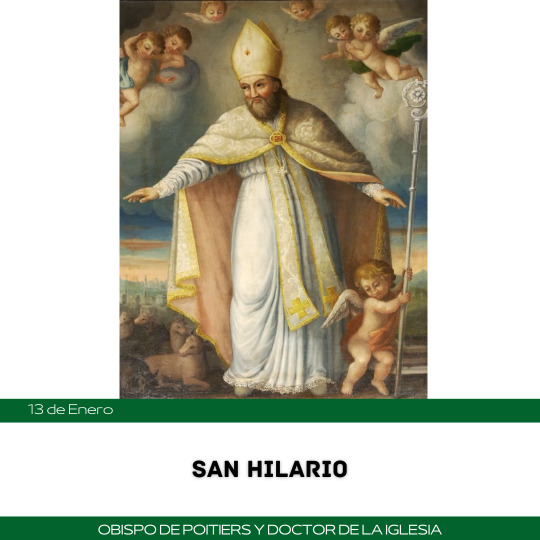
SAN HILARIO, OBISPO DE POITIERS Y DOCTOR DE LA IGLESIA
Filósofo y literato pagano, de familia acomodada, se convierte al cristianismo en el 345. Como obispo de Poitiers se opone a la herejía arriana que contesta la doble naturaleza de Jesús, divina y humana. Padecerá también el exilio por defender la verdad.
SAN HILARIO, OBISPO DE POITIERS Y DOCTOR DE LA IGLESIA
13 enero
Los orígenes y la conversión
Tan escasas son las noticias sobre su vida, como en cambio abundantes son las obras teológicas que este verdadero Defensor Fidei nos ha dejado. Nacido en una familia acomodada galo-romana y pagana, recibe una sólida formación literaria y filosófica, pero solamente luego de la conversión al cristianismo - como él mismo declarará en una de sus obras - logra encontrar el sentido del destino del hombre. Es en particular con la lectura del prólogo al Evangelio de Juan, que Hilario inicia y da una dirección a la propia búsqueda interior. Adulto, casado y con una hija, recibe el Bautismo y entre el 353 y el 354, es elegido obispo de Poitiers.
La lucha contra la herejía
El período histórico en el que San Hilario vive, está particularmente caracterizado por un pluralismo religioso y cultural que con pesadas polemicas melló el núcleo central de la fe cristiana. En particular, las doctrinas de Arrio, Ebión y Fotino - por citar solamente algunas - encontraron terreno fértil ya sea en Occidente que en Oriente, difundiendo herejías trinitarias y cristológicas que comprometían el núcleo central de la fe cristiana. Con coraje y profunda competencia, San Hilario inicia su “lucha” contra la polémica trinitaria y en particular contra el arrianismo, sosteniendo en cambio que Cristo, solo si es verdadero Dios es verdadero hombre, puede ser el salvador de los hombres. En este clima encendido, San Hilario pagó con el exilio el compromiso por el restablecimiento del orden en el pensamiento teológico y por el retorno a la verdad.
El exilio y el regreso a Poitiers
Estamos en el siglo IV, durante el imperio de Constanzo, hijo del emperador Constantino el Grande. San Hilario escribe una súplica al emperador - Liber II ad Constantium – pidiendo poder defenderse públicamente, en presencia del mismo emperador, de las acusaciones que Saturnino de Arlés injustamente le habia dirigido, indicándolo como traidor de la verdadera fe evangélica y obligándolo al exilio en Frigia (en la actual Turquía) por 4 años. Instigado por los arrianos que querían deshacerse de Hilario, Constantino lo vuelve a enviar a Poitiers donde, en cambio, es acogido triunfalmente. Regresando a su patria, retoma la actividad pastoral apoyado también por el futuro obispo de Tours, S. Martín, que bajo la dirección de Hilario funda en Ligugé el más antiguo monasterio de la Galia, con el objetivo de contrastar los efectos de la herejía. En los ultimos años de su vida compone un comentario a cincuenta y ocho Salmos. Muere en el 367 y de él han quedado escritos exegético-teológicos e himnos de argumento doctrinal. Entre sus obras, se encuentra también el Comentario al Evangelio de Mateo, el más antiguo comentario en lengua latina de este Evangelio. Sus obras fueron publicadas por Erasmo de Rotterdam en Basilea en 1523, 1526 y 1528.
Las palabras de Benedicto XVI
En 2007, continuando el ciclo de catequesis sobre los Padres Apostólicos, el Papa Benedicto se ha detenido sobre la figura de Hilario de Poitiers resumiendo lo esencial de su doctrina en esta fórmula del Santo: “Dios sólo sabe ser amor, y sólo sabe ser Padre. Y quien ama no es envidioso, y quien es Padre lo es totalmente. Este nombre no admite componendas, como si Dios sólo fuera padre en ciertos aspectos y en otros no”.
0 notes
Text
Want this soooooo badly (but it would probably bankrupt me 😖😖)
Made in 1988 by Royal Worcester to celebrate the 400th anniversary of the defeat of the Spanish Armada - "Queen Elizabeth reviews her troops at Tilbury". Only 100 were ever made, but this is just beautiful ♥️👑
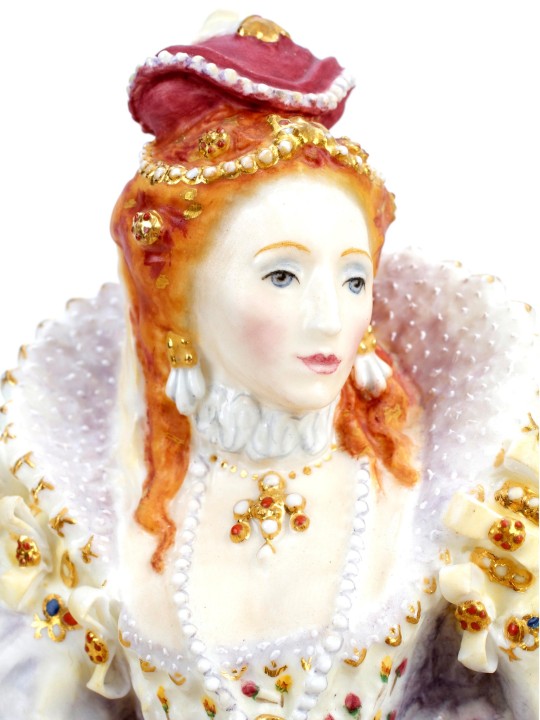
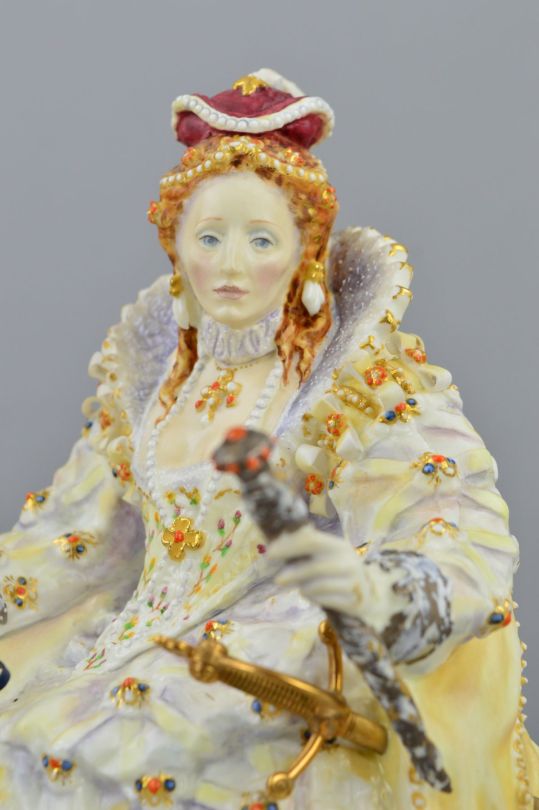
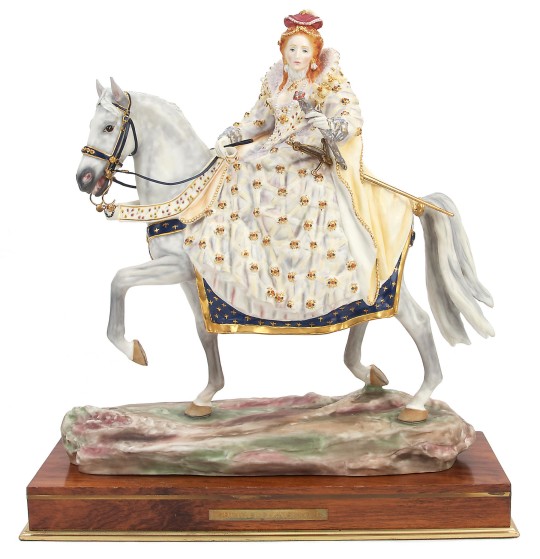
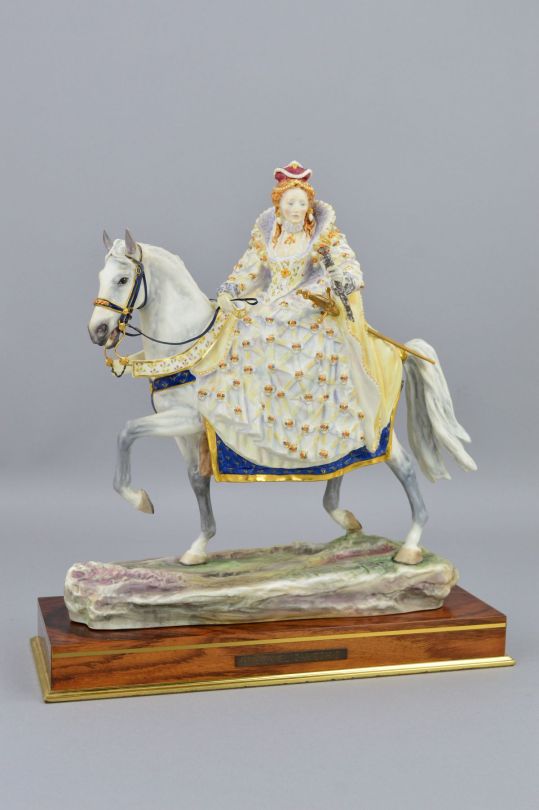
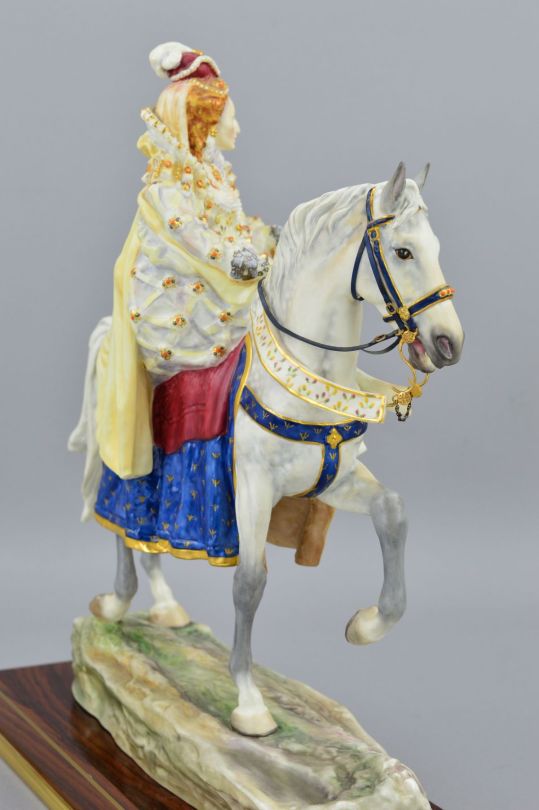
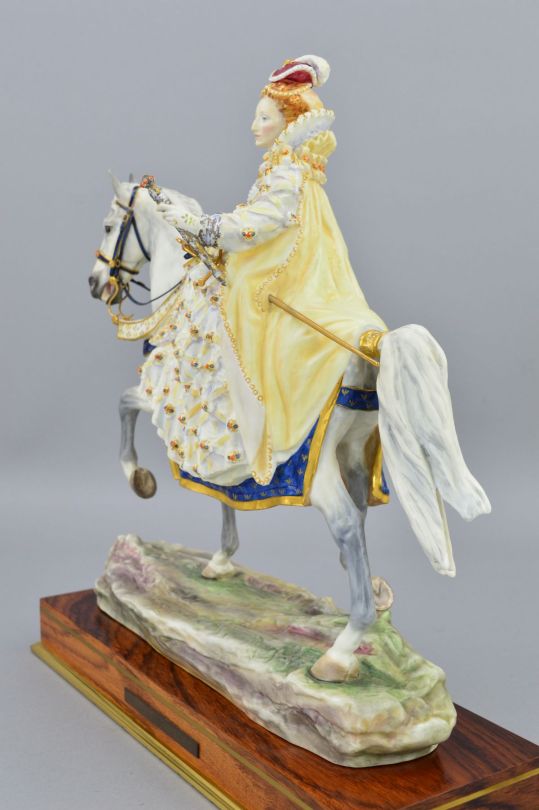
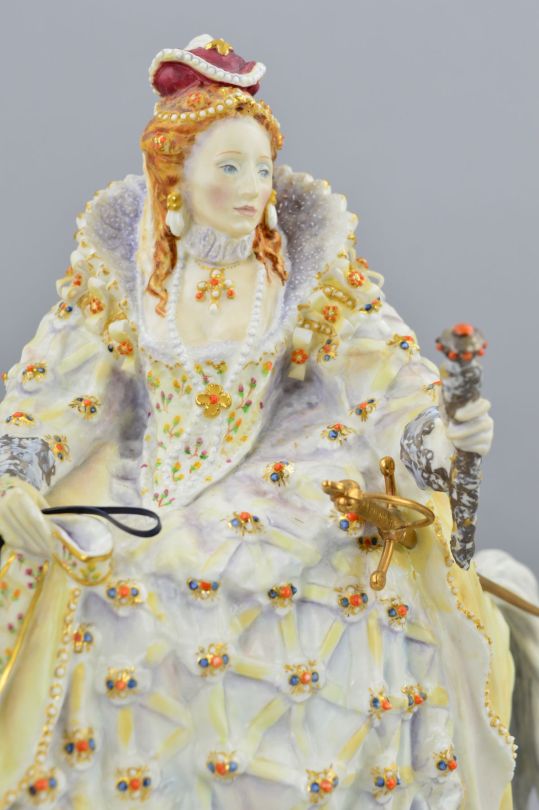
#elizabeth#queen elizabeth#queen elizabeth I#queen of england#tudor#tudors#figurines#royal worcester#1988#defeat of the spanish armada#Tilbury#i know i have the body of a weak and feeble woman#beautiful#GSTQ#fidei defensor#the only royal ginger who matters#henry viii#anne boleyn#👑♥️👑♥️
43 notes
·
View notes
Text
nothing will ever quite capture the inanity of the british monarchy quite as well as the fact that they STILL use the “defender of the faith” title
3 notes
·
View notes